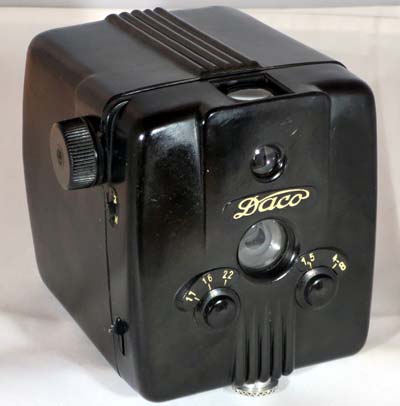Dacora Daco I
Specification

| Manufacturer | : | Dacora |
|---|---|---|
| Produced | : | 1949 |
| Classification | : | Medium Format |
| Body Type | : | Box |
| Construction | : | Bakelite |
| Film Type | : | 120 |
| Film Width | : | 62mm |
| Image Size | : | 2¼ x 2¼ in |
| No. of Images | : | 12 |
| Lens Type | : | meniscus + close-up |
| Focal Length | : | 95mm |
| Focus Type | : | variable |
| Focal Range | : | 1.5m and 4m-inf. |
| Aperture Type | : | Multihole |
| Apertures | : | f/11, f/16 and f/22 |
| Shutter Type | : | Rotary |
| Shutter Speeds | : | T, I*(1/120s) |
| Size (w x h x d) | : | 85 x 90 x 100 mm |
| Weight | : | 395g |
| * Measured on this camera | ||
Art Deco Credentials
![]()
![]()
![]()
Noteworthy: Worth giving special attention
I consider this camera to warrant 3 stars for the following attributes:
- produced after the main Art Deco period
- Art Deco Streamline Moderne design
- moulded Bakelite body with rounded corners
- geometric multiline ribbed mouldings
- symmetrical layout to front
- Art Deco lettering on front
Description
The Daco I is a medium format box camera made by Dacora and introduced in 1949. The body is made from Bakelite with slightly curved sides and rounded corners. The rounded nature of this camera reflected the Streamline Moderne era in American Art Deco. The camera uses 120 film taking twelve 6x6cm images per roll.
It has a two speed rotary type shutter supporting instant and time modes. The lens is a meniscus f/11. The controls on the front gives a choice of apertures f/11, f/16 and f/22. Normal focus range is 4m to infinity but a close-up lens can be swung into place to focus down to 1.5m. It has a single reflecting viewfinder for waist level operation. It has a single tripod mount.
It is similar to the Daco II which was introduced in 1950 but this has an f/8 lens.
How to Use
This camera takes 120 film which is widely available. It is advisable to cover the red window except when winding film in low light.
The aperture choice is f/11, f/16 or f/22. The measured speed on this camera was 1/120s. As the shutter speed is only 1/120s, it is advisable to use a tripod or hold it against a wall or other solid object to get shake-free images. For quick snapshots, hold it firmly against your body.
The table shows how this camera will perform using ISO 100/125 film. It is based on the 'Sunny 16' rule. Modern film is so forgiving and will produce acceptable results even when overexposed by 2 or 3 stops or underexposed by 1 stop.
The tables assume that the sun is at least 30 degrees above the horizon - that's 10am - 5pm on a summers day (May-August) in the UK.
Remember that the exposure guide in the manual may not be helpful as it is based on the use of old film with a low ISO value.
Using ISO 100/125 film - shutter speed 1/120s
| Weather Conditions | Shadow Detail | Aperture | Exposure |
|---|---|---|---|
 Sunny SunnySnow/Sand | Dark with sharp edges | f/22 | Good |
 Sunny Sunny | Distinct | f/16 | Good |
 Slight Overcast Slight Overcast | Soft around edges | f/11 | Good |
 Overcast Overcast | Barely visible | f/11 | -1 Stop Underexposed Acceptable |
 Heavy Overcast Heavy Overcast | None | f/11 | -2 Stops Underexposed Not Acceptable |
 Open Shade Open Shade/Sunset | None | f/11 | -3 Stops Underexposed Not Acceptable |